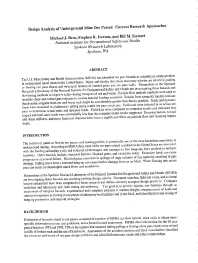Mining Publication: Design Analysis of Underground Mine Ore Passes: Current Research Approaches
Original creation date: May 1998
The U.S. Mine Safety and Health Administration (MSHA) has identified ore pass hazards as a significant safety problem in underground metal mines in the United States. Injury and fatality data show that many injuries are related to pulling or freeing ore pass chutes and structural failures of control gates and ore pass walls. Researchers at the Spokane Research Laboratory of the National Institute for Occupational Safety and Health are investigating these hazards and developing methods to improve safety during transport of ore and waste. Particle flow analysis methods were used to simulate chute and control ate response to various material loading scenarios. Results from computer models indicate that dynamic impacts from ore and waste rock might be considerably greater than theory predicts. Static and dynamic loads were measured in a laboratory setting using scaled ore pass mock-ups. Field tests were initiated in an active ore pass to determine actual static and dynamic loads. Fields data were compared to computer results and indicated that impact and total static loads were substantially less than the computer model results suggested. Damping factors, normal and shear stiffness, and mass frictional characteristics have a significant effect on particle flow and resulting impact loads.
Authors: MJ Beus, SR Iverson, BM Stewart
Conference Paper - May 1998
Presentation at the 100th CIM Conference (Montreal, Quebec, Canada, May 3-7, 1998); 8 pp
See Also
- Effects of Far-Field Shearing Deformation on Fracturing Around an Underground Opening
- Electromagnetic Noise in Lucky Friday Mine
- Proceedings of the Second International Workshop on Coal Pillar Mechanics and Design
- Propagation of EM Signals in Underground Metal/Non-Metal Mines
- Propagation of EM Signals in Underground Metal/Non-Metal Mines: Magma Copper Company - San Manuel Mine
- SPONCOM - A Computer Program for the Prediction of the Spontaneous Combustion Potential of an Underground Coal Mine
- SponCom - Spontaneous Combustion Assessment Software - 2.0
- Static and Dynamic Loads in Ore and Waste Rock Passes in Underground Mines
- Technology News 501 - Measuring Very Low Air Velocities in Underground Metal/Nonmetal Mines
- Technology News 545 - NIOSH Updates Spontaneous Combustion Assessment Software
- Page last reviewed: 9/21/2012
- Page last updated: 9/21/2012
- Content source: National Institute for Occupational Safety and Health, Mining Program


 ShareCompartir
ShareCompartir
